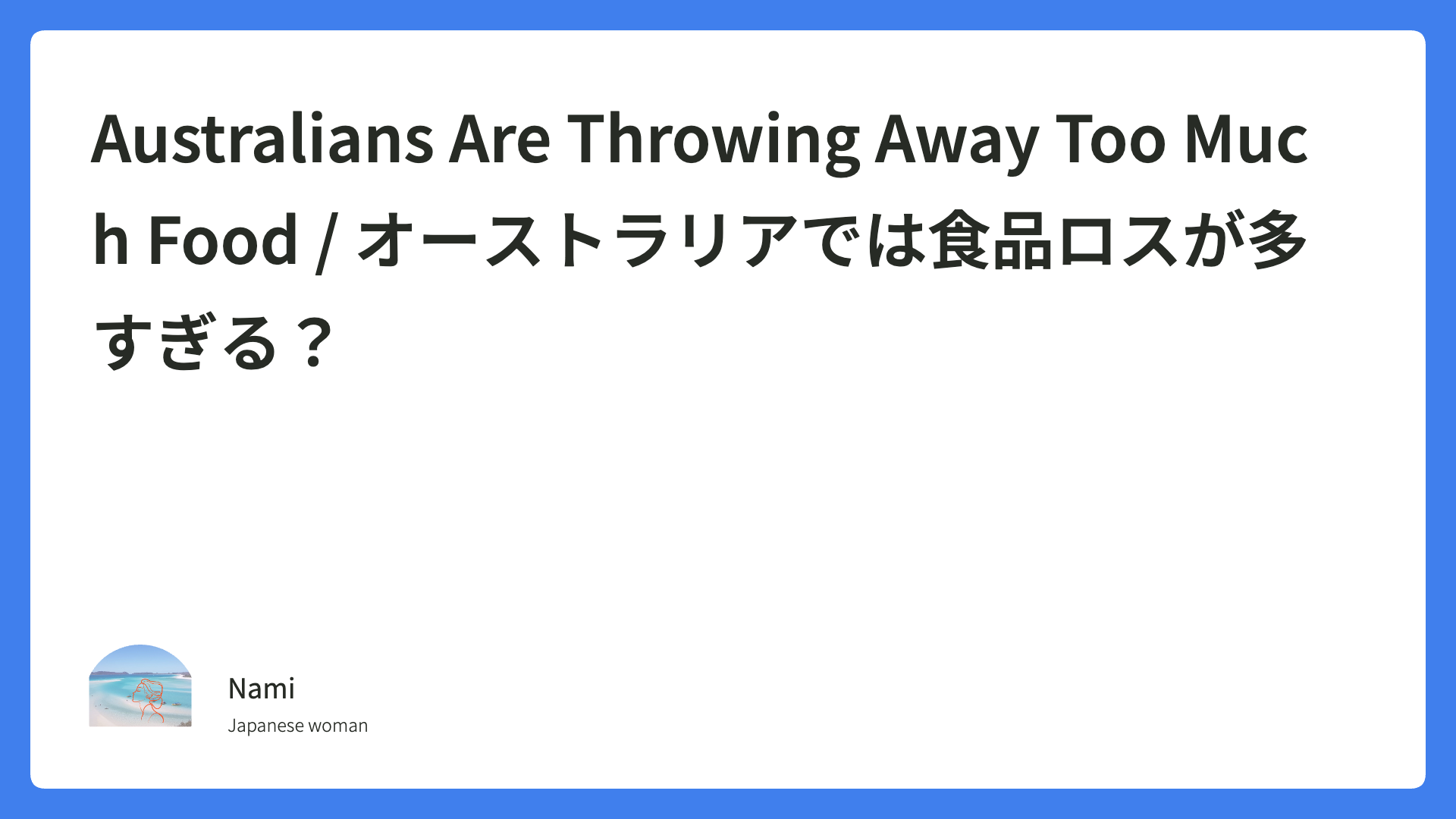Australians Are Throwing Away Too Much Food / オーストラリアでは食品ロスが多すぎる?

dated: 19Jun2025
Summary
English
Many Australians think they don’t waste much food. But research shows that, without knowing it, people may throw away about $2,500 worth of food every year.
According to Foodbank Australia, people in Australia throw away about 7.6 million tonnes of food each year. That’s around 312 kilograms per person- around 2 kilograms per person per week.
Previous studies showed that many consumers wanted to make the best choices for their families when it comes to ‘use-by’ and ‘best before’ labels.
Some people have more difficulty reading food labels — such as those with poor eyesight or people who speak limited English.
These groups are more likely to misread “best before” or “use by” dates and throw away food that is still good.
Researchers held workshops with different groups: designers, food makers, supermarkets, government workers, and regular shoppers.
They tested new food label designs with helpful features like:
- Clear warnings such as “Do not eat after this date”
- Color changes to show freshness
- QR codes to give more information
As a result, people preferred labels that were:
- Simple
- Easy to read
- Visually clear
- Included storage advice
But they had different opinions.
Manufacturers and stores worried about:
- Food safety
- Following legal rules
- The cost of changing labels
Meanwhile, shoppers focused more on:
- Keeping food fresh
- Understanding the labels
- Wasting less food
Researchers hope their work will help create better food labels — so people can make smarter choices and waste less food.
Japanese
多くのオーストラリア人は、自分があまり食品を無駄にしていないと思っています。
しかし、実際には知らないうちに年間約2,500ドル分の食品を捨てている可能性があることが、ある研究でわかりました。
フードバンク・オーストラリアによると、オーストラリアでは毎年約760万トンもの食品が捨てられています。1人あたりに換算すると年間約312kg、つまり週あたり約2kgです。
以前の調査では、多くの消費者が「消費期限(use-by)」や「賞味期限(best before)」に関して、家族のために最良の選択をしたいと考えていることがわかりました。
視力が弱い人や、英語力が限られている人は、食品ラベルを読むのが難しいことがあります。
その結果、これらの人々は「賞味期限」や「消費期限」を読み間違え、まだ食べられる食品を捨ててしまう可能性が高くなります。
とある研究で、デザイナー、食品メーカー、スーパーのスタッフ、政府関係者、一般の買い物客など、さまざまな人々とワークショップが開催されました。
そこでは、以下のような工夫を加えた新しい食品ラベルのデザインが用意されました:
- 「この日以降は食べないでください」といった明確な警告
- 鮮度を示す色の変化
- より詳しい情報が得られるQRコード
その結果、人々が好んだのは以下のようなラベルでした:
- シンプル
- 読みやすい
- 見た目で分かりやすい
- 保存方法のアドバイスがあるもの
ただし、関係者によって重視するポイントは異なっていました。
食品メーカーや小売業者が重視したのは以下でした:
- 食品の安全性
- 法規制の順守
- ラベルを変更するためのコスト
一方、消費者が重視していたのは以下の通りでした:
- 食品の鮮度を保つこと
- ラベルのわかりやすさ
- 食品ロスを減らすこと
研究チームは、今回の取り組みが、よりわかりやすく実用的な食品ラベルの実現につながることを目指しています。そして、人々が食品についてより賢く選び、ムダを減らすきっかけになることを期待しています。
Comment
🍱 Understanding Food Loss in Japan: Labeling Rules and the Hidden Waste
I used to think that Japan had more food waste than other countries, mainly because of its strict food labeling rules. However, when I looked into the actual numbers, I was surprised.
According to a 2022 survey by Japan’s Ministry of Agriculture, Forestry and Fisheries, the total annual food loss in Japan was about 4.72 million tons.
Here’s the breakdown:
- Household food loss: about 2.36 million tons
- Business-related food loss (e.g. unsold items at stores, leftovers from restaurants): also 2.36 million tons
Surprisingly, the amount of food wasted at home and in businesses is nearly the same.This translates to approximately 38 kg of food waste per person per year.
日本では、賞味期限や消費期限の表示ルールが厳格であるため、「フードロスも他国より多いのでは?」と漠然と感じていました。実際、農林水産省の調査(2022年度)によると、日本の年間食品ロス量は約472万トン。農林水産省の調査(PDF/外部リンク)
その内訳は、
- 家庭から出る「家庭系食品ロス」:約236万トン
- 小売店の売れ残りや飲食店の食べ残しなどによる「事業系食品ロス」:約236万トン
と、家庭と事業の両方でほぼ同じ量が発生しています。1人あたりに換算すると、年間約38キログラムの食品が捨てられている計算です。
🏷 How Japan Labels Expiry Dates / 消費期限と賞味期限
In Japan, food labeling laws clearly distinguish between:
- Use-by date: the deadline for safe consumption (e.g. lunch boxes, sandwiches, prepared meals)
- Best-before date: the date indicating when the food retains its best quality (e.g. dried goods, snacks, canned food)
However, many consumers mistakenly believe that they must eat food before any printed date, leading to perfectly edible food being thrown away.
Another cause of food waste is the “One-Third Rule” used in Japan’s food supply chain.
For products with a best-before date, the time between production and expiry is divided into three equal parts:
- The first third is the deadline for delivery to retailers
- The second third is the sales period in stores
- The final third is often when products are removed from shelves, returned, or discarded
🔍 For example:
If a product’s best-before date is 90 days after production, it may be removed from store shelves even with 30 days left until expiry.Some companies are now reviewing this rule and switching to “month-year” labeling to reduce waste.
日本では、食品表示法により「消費期限」と「賞味期限」がはっきりと区別されています。
- 消費期限(Use-by):安全に食べられる期限(例:お弁当、サンドイッチ、総菜)
- 賞味期限(Best-before):品質が保証される期限(例:乾物、お菓子、缶詰)
ただし、現状では「期限=食べてはいけない」と誤解されることが多く、本来まだ食べられる食品まで廃棄されてしまうケースが目立ちます。
日本の流通業界には、「賞味期限までの期間を3等分して管理する」という『3分の1ルール』があります。
たとえば賞味期限が製造から90日後の商品なら:
- 最初の30日以内に小売店へ納品
- 次の30日以内に店頭で販売
- 残りの30日は販売対象外(返品・廃棄の可能性)
つまり、賞味期限が1か月以上残っていても、店頭から撤去されることがあるのです。
この慣習が、まだ食べられる食品の廃棄を生む一因になっています。最近は、年月表示への切り替えや、ルール見直しの動きも広がっています。
Can We Compare Japan and Australia?/ オーストラリアとの比較
At first glance, Japan appears to have less food waste than Australia.
However, we need to be careful when comparing the numbers:
- Japan’s “food loss” refers only to edible food that is thrown away (excluding inedible parts)
- Australia’s “food waste” often includes all waste—edible or not—from households, farms, and businesses
These differences in definitions and data collection methods can significantly affect the numbers.
数字だけを見ると、日本のフードロス量はオーストラリアよりも少なく見えます。
しかし、単純に比較することはできません。
- 日本の「食品ロス」は、「本来食べられるのに捨てられた食品」に限定(可食部分のみ)
- オーストラリアの「フードウェイスト」は、可食・不可食を問わず、家庭や農場、流通過程すべてを含めて集計されることもある
このように、定義や統計のとり方の違いによって、数字には大きな差が出ることがあります。
What We Can Do/ 私たちにできること
Strict labeling, business habits, and consumer misunderstandings can all lead to invisible food loss.
By learning about these systems, we can begin to take small steps toward reducing waste.
Why not start by checking the labels more carefully—or rethinking what “expiry” really means?
消費期限や賞味期限に対する私たちの意識、そして商慣習が生む「見えない食品ロス」——
こうした仕組みを知ることで、まだできることがあると感じます。食べ物を大切にするために、ちょっとした意識の変化から始めてみるのもよいかもしれません。



コメントを残す